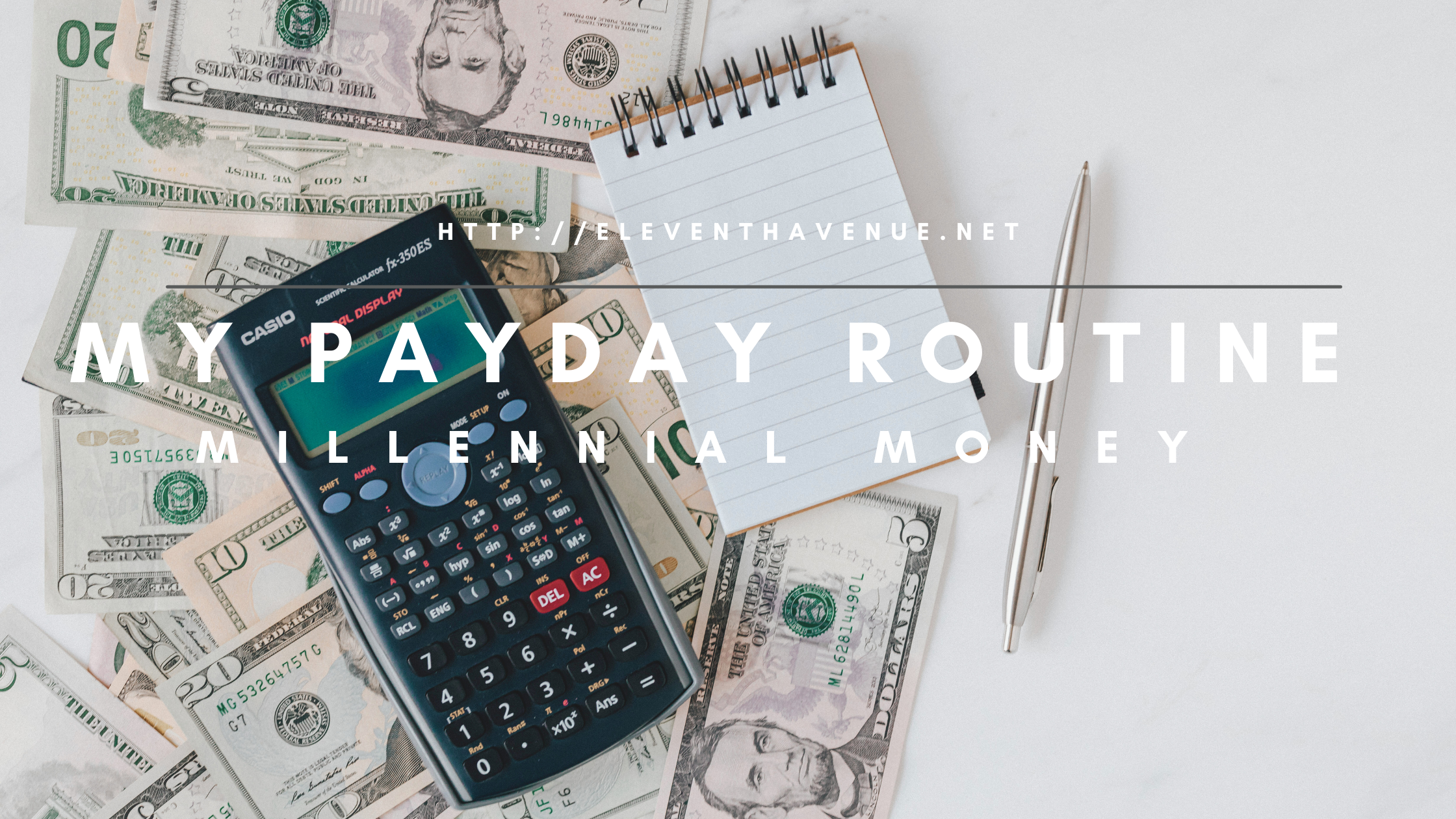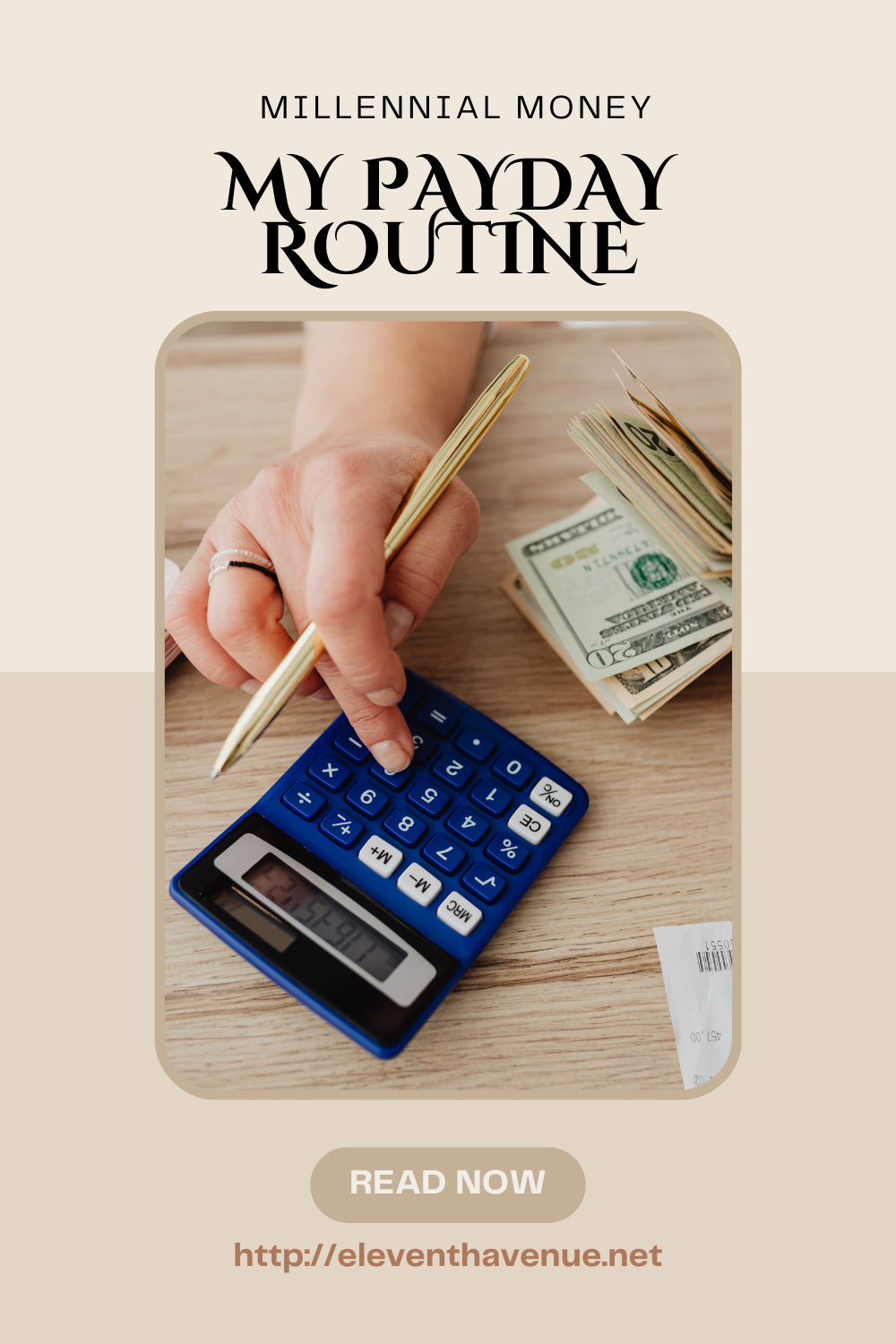My Payday Routine | Millennial Money

Despite my maternity leave, my payday routine hasn’t changed since I receive bi-monthly pay from the government. The only difference is the amount!
Even though maternity pay is significantly less, I still stick to my payday routine to alleviate financial stress and ensure I don’t go into debt while on leave. It also allows me to save continuously, pay bills, and spend accordingly. This routine has been with me for several years and hasn’t changed!
Here’s my payday routine to help alleviate financial stress:
Pre-Payday (1 or 2 days before the scheduled payday)
I wrote about how I set up my bank accounts for success over here. 99% of the time, I typically have $100 sitting in my chequing account. This $100 is left over from my previous pay and it’s meant to be a floater in case a store only accepts debit or I need to withdraw cash. It’s pretty rare for my account to drop to less than $100 one or two days before payday.
On this day, I distribute the $100 into my sinking funds and miscellaneous items I’m saving for but not in a rush to get.
As I typically get paid twice a month, a minimum of $200 goes towards sinking funds and miscellaneous savings.
A few of my sinking funds are the CPHR membership fees, yearly city utilities, unexpected strata fees, gifts, and family vacations. A few random miscellaneous things I’m saving for are a laptop, (cat) litter robot, ring repair, and wireless headphones.

On Payday
Yay, it’s payday! My deposits hit the bank around midnight so by the time I wake up, I would start my payday routine. I typically like to get it done first thing with my coffee so it’s out of the way and I don’t get sidetracked with other tasks. I hate distractions when it comes to finances!

Since I leave $100 in my chequing account, where does all the money go?!
I always pay myself first. Some may disagree with putting away money if you have massive debt (since most saving/investment returns can’t outpace high credit card interests), but I disagree. I like putting away money for my future; even if money is tight, I make sure to put something away.
I allocate money into these funds:
- My RRSP (retirement account)
- Pet emergency funds (I have a fully funded emergency fund so I’m now focusing on a dedicated pet EF since I don’t believe in pet insurance)
- Theo’s RESP (education account)
- Theo’s investments (an investment account I want to give Theo when he’s 18 or 25)
- Stocks (I don’t play with stocks too much. I invest about $50-100/month to buy and hold big names as opposed to trying to get rich quickly)
- House build/renovations (houses in Vancouver are a minimum of $1.2m; we plan to save money to tear down the family house and rebuild it since there’s no need to buy the land)
- Building wealth (a random savings account… maybe an inheritance for the kids? Who knows)
Once I finish paying myself, I look at my cash-only bills and cash-only debts. These are the types of bills/debt that are taken out of my bank account (aka cash only) instead of being billed via credit card. With the remaining balance and what’s coming up soon, I will transfer the total amount of bills and debts into another account called “Money Pending Transfer”. For example, my car insurance, strata and mortgage payments are all withdrawn from my bank.
After my “cash-only” expenses and debts are funded, I focus on paying my credit cards or line of credit. As someone who used to abuse credit cards, I hate carrying a balance now. I typically don’t wait for a statement to come, I just pay whatever the balance is at the time.
Lastly, if I have any leftover money (largely depending on how much expenses I accrue monthly), I will take a look at my investments, savings, and sinking funds and allocate the funds to whichever category I feel is lacking.
After Payday
After allocating all my funds, I take a few minutes to review my budget and see how I’m progressing throughout the month. If I’m getting close to reaching the limit in a category, I make a mental note to slow down.
When the next payday is coming up, I repeat the whole routine! The only changes I may make would be the type of accounts I pay myself first, such as, I may choose to skip funding my stocks account and put more towards my retirement funds for this paycheck.

The Future of my Routine
This has been my payday routine for years and it works well for me. I remember explaining to Dan why I had my money scattered around everywhere a few times! As we’re planning for our future and want to give Theo (and any future kids) a head start in life, Dan and I discussed how to manage our household funds.
We’ve realized that when I return to work, my sole income will be enough for the both of us to live off. We like to keep our expenses separate so if I had one of my paychecks, and Dan had the other one (since I get paid bi-weekly), we would be able to keep our expenses separated. So, we plan to live off my income and use Dan’s income solely to pay off our mortgage aggressively. We haven’t discussed what would happen after the mortgage gets paid off, but if the routine works for us, we’ll probably use his salary to save and invest!
*I am not a personal finance planner and this is not meant to be taken as professional financial advice. This routine is what works best for me. Please do some research to see what is best for you and your situation.










I love how organized you are with your payday routine! It’s impressive how you manage to stick to it even with the changes in your income. It’s such a great way to keep financial stress at bay and make sure you’re always on top of things.
Lenne | lennezulkiflly.com
I don’t know how I ever managed to organize my finances before establishing a payday routine. It’s been a game changer once I figured out what worked best for me!
Great post!
Thank you!